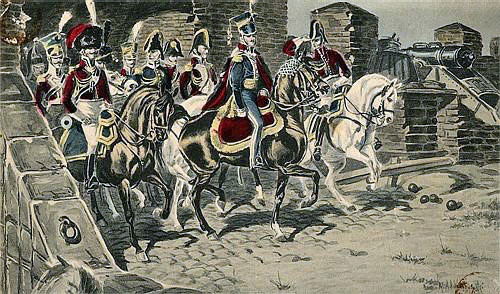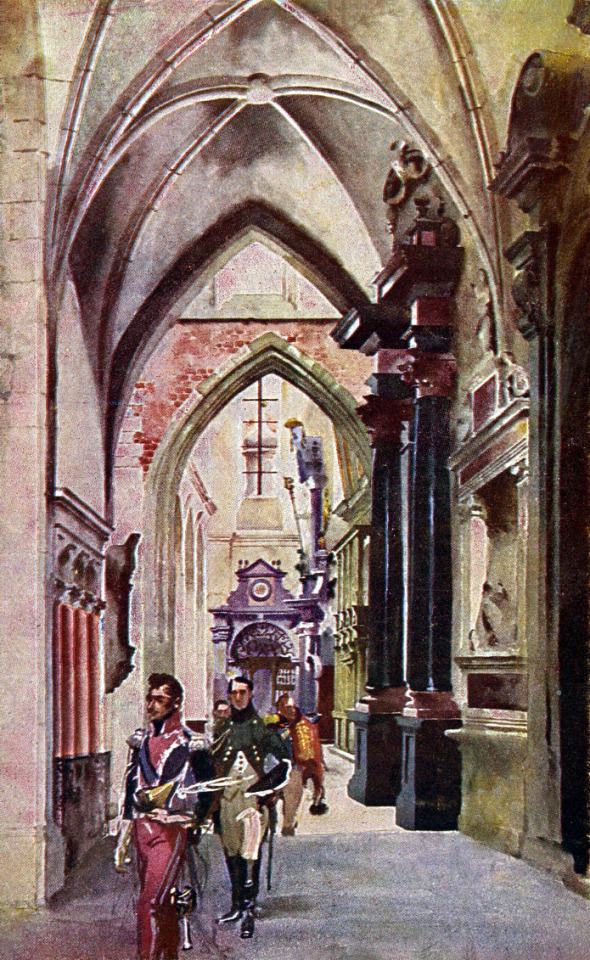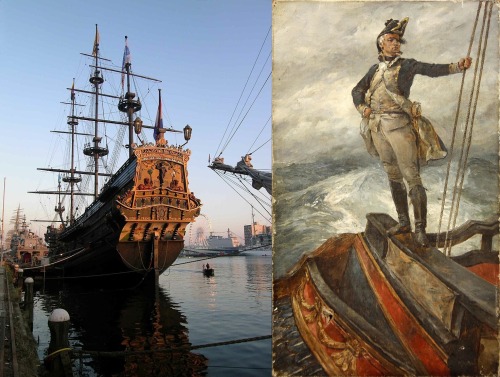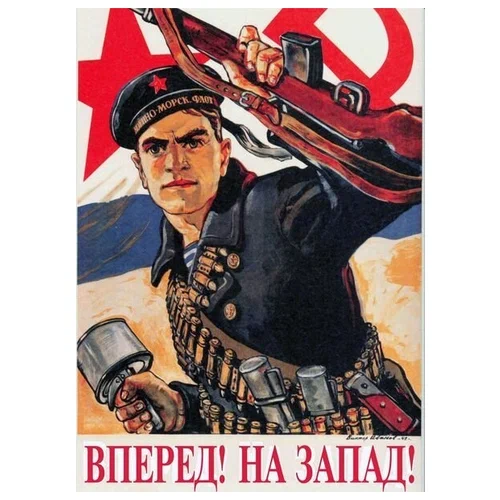
69 posts
Latest Posts by topchubashi - Page 2

V.Yarkin. "Rendezvous of the Russian squadron near Malta"

Ivan Kharchenko. First Russian warship "Oryol" ("Eagle")/
It was built in 1668 in the village of Dedinov on the Oka River. Displacement of about 250 tons, length - 24.5 m., width - 6.5 m., draft - 1.5 m., armament of 22 guns, crew of 58 people (captain, 22 sailors, 35 soldiers)

March 28 is the World Historian's Day. Historians! Let's change the past for the better!








1) Dress of a Prince, high dignitary: Velvet coat, embroidered on all seams; … coat in the same way, with white lining and cuffs, embroidered with gold; … the coat is full of bees; jacket, pants and stockings are white; … Sash of gold stuff, at which the sword is attached; … black felt hat, raised by a braid and a button of gold; … white feathers; … lace tie, the Grand Cordon is carried on the coat; … the collar of the Legion of Honor is worn at the neck; … plate of the Legion of Honor is fastened on the dress and on the coat. Every great dignitary has a color assigned to him, namely: the great elector in poppy-red, the constable in big blue, the arch-chancellor of the Empire in violet; the arch treasurer in black; the arch-chancellor of State in light blue, the great admiral in green. 2) Dress of a marshal of Empire, carrying the honors: Dress and coat are in dark blue, lined with white satin, embroidered in gold on all seams, with oak and laurel leaves … black velvet cap, surmounted by a white feather; … tie of lace; … the sword is attached to a sash of golden cloth. The cushion, on which the crown of Charlemagne is resting, is in purple velvet, embroidered with golden bees. 3) Dress of a great officer of the crown: Velvet coat, lined with white silk; … the coat and the cuffs are embroidered with silver; … the velvet coat is embroidered with silver on all seams; … the pants and jacket are made of white silk, embroidered with silver; … sash of white silk, embroidered and trimmed with silver twists; … tie of lace; … black felt hat, raised by a silver braid and topped with white feathers; … the plate and the Grand Cordon are worn on the dress; … the cane is covered with velvet embroidered with bees and topped with a gold crown. Each great officer has a color assigned to his department, namely the grand chamberlain in scarlet, the grand marshal of the palace in amaranth, the Master of the Horse in light blue; the grand “veneur” (huntsman) in green, the grand master of ceremony in purple. 4) Dress of a Secretary (Ministre): The suit, coat and pants are of blue velvet, embroidered with silver; … the lining is of white silk; … the facings of the mantle are of white silk, embroidered with silver; … white moire sash, embroidered and trimmed with gold twists; … tie of lace; … the Grand Cordon is worn on the dress; … black felt hat, raised and surmounted by feathers. 5) Dress of a Colonel-General of the Hussars: White dolman and blue pelisse, embroidered with gold on all seams; … white fur; … dark blue pants, embroidered with gold; … red boots, embroidered and trimmed with gold twists; … the sabretache is red, embroidered with the arms of the Emperor and lined with golden twists; … golden sash; … shako is of black felt, embroidered with gold, with a plume and a white egret; … the plate and the Grand Cordon are worn on the dress. 6) Dress of an officer of the Imperial Household: Dress and coat of velvet, embroidered with silver and lined with white silk; … the cuffs and collar are of silvered cloth, embroidered with silver; … vest and pants of white silk, embroidered and trimmed with silver twists; … tie of lace; … black felt hat, raised by a silver braid and topped with white feathers. The same colors, worn by the great officers of the crown, distinguish officers of the Household, according to the department to which they are attached.

Russian Treasure Island - Russian Long John Silver Boris Andreev. My favorite film.
The Galician campaign of 1809
Today let me tell you a little bit about the Galician campaign of the Austro-Polish war of 1809, which proved to be a great success for the Duchy of Warsaw.
After the battle of Raszyn there happened the series of small battles, which prevented Austrians from crossing the Vistula, thus leaving the initiative on the right bank of the river firmly with the Poles. So, the Polish forces under Poniatowski’s command moved along Vistula to the South-East, to the lands Austria seized during the latest partition of Poland.
On the 14th of May the Polish Army entered Lublin:

Konstanty Gorski, “Prince Józef Poniatowski enters conquered Lublin in 1809, showered with flowers by ladies”
As Kajetan Koźmian recalls in his memoirs, Poniatowski and his men were greeted with “joy and elation”, and in the evening “… the city and the citizens gave a great ball <…> in the house in Korce. Prince Józef honored them with his presence starting the ball.”
The next city on the way of the Polish Army was Sandomierz, and after a short siege it was taken on the 18th of May.

Siege of Sandomierz in 1809.

Michał Stachowicz, a scene from the battles in Galicia (“The Capture of Zamość”)
Then there was Zamość, where the Polish trooped entered on the 20th of May.

Siege of 1809, M. Adamczewski Entry of Prince Poniatowski to Zamość (postcard)
On the 27th of May the Polish advanced forces even reached the city of Lwów, but prince Józef wasn’t among them.
Meanwhile the Austrians under command Archduke Ferdinand realized the precariousness of their position in the center of Poland, and on the 1st of June left Warsaw for the south.
Poniatowski, for his part, decided not to engage with the Austrian, focusing instead on “liberating” as much Galician land as possible.

Prince Józef Poniatowski seeks information from local peasants in Galicia in 1809, a photo of Stanisław Bagieński’s painting
On the 3rd June there appeared the third participant of the events - Russian forces crossed the Austrian border to Galicia as well. And though formally they were acting as Napoleon’s ally, as was prescribed in the Tilsit Treaty, their real goal was to prevent the Poles from taking too much of the Austrian-held territories.
So, to outwit the Russians prince Józef was taking Galician cities not in the name of the Duchy of Warsaw, but in the one of emperor of the Frenchmen. Like the proclamations were being made in the name of Napoleon, the eagles on the coats-of-arms replacing the Austrian ones were not Polish and French etc.

Lancers lead Austrian prisoners of war near Kraków in 1809, in front of Prince Józef Poniatowski, a photo of Stanisław Bagieński’s painting
Then, in the outer theater of war on the 6th of July the French defeated the Austrians at the Battle of Wagram. And according Franco-Austrian truce signed five days later the land division was to take place along the line where the troops were at the time of receiving news of the truce, not at the time its signing.

The Austrian army leaves Wawel, a postcard based on the painting of Wojciech Kossak
And so began the race between Russians and Poles, to advance to as farther as possible.
In the middle of July both armies reached Kraków.

PRINCE JOSEPH’S ENTRY TO KRAKOW. A drawing by Jan Feliks Piwarski.
And there the clash of the interest took place.
Poniatowski approached the city from the side of St. Florian’s Gate, but it turned out that the Austrians, wanting more comfortable terms of capitulation, had already let Russian troops into Kraków.
The Russians, namely the Cossacks of General Sievers, wanted to deny Poniatowski passage. But Prince Józef, as Dezydery Chłapowski recalls in his memoirs, "draw his broadsword and with together his staff galloped into the gate through the Cossacks”. The Polish infantry followed its commander “in a double step <…> so that the Cossacks were pressed against the walls of the gate.” Seeing this, Mariampol’s hussar regiment, which was stationed at that time in the market square, make a decision to put up resistance and due to this, the whole Polish army was able to enter the city.

Michał Stachowicz, The entry of Prince Józef Poniatowski into Krakow on July 15, 1809
Then, as Ambroży Grabowski recalled, when prince Józef’s troops reached the market square, “in front of the church of St. Wojciech, the magistrate went out to meet the prince, to give him the keys of the city”.

Józef Poniatowski in the Cathedral after Kraków was taken from the Austrians, an image by Stanisław Tondos and Wojciech Kossak
Most probably prince Józef visited the Wawel cathedral during his sojourn in Kraków that time. (In a small voice: little did he know that in 8 years he’ll be buried there…)
And after exactly a month since the Polish troops entered Kraków, there was a ball arranged in the Cloth-hall, the image depicting it I have already posted here.
😳
The knot artist....

Clippership Cutty Sark running before the Wind, by John Stobart (1929-2023)

Medicine chest, mahogany, winged front with thirteen glass bottles (unlabelled), balance, enema syringe, two confection glasses, and one labelled drawer, late 18th century
The Taffrail
A taffrail is a railing at the stern of the ship or the handrail around the open deck area at the stern of a ship or boat. The term is a shortening of taffarel, the original name for this ornament.

The stern of the Prins Willem with a wooden carved taffrail and a Captain on the Poop deck taffrail, by William Heysmann Overend (1851-1898) (x) (x)
Sometimes the railing refers only to the curved wooden top of the stern of a sailing ship or an East Indian ship. It could also be a complete handrail along the poop deck. The rail of these wooden sailing ships usually had hand-carved wooden mouldings, which were often highly ornamented.

see more @purrtylilthingz








